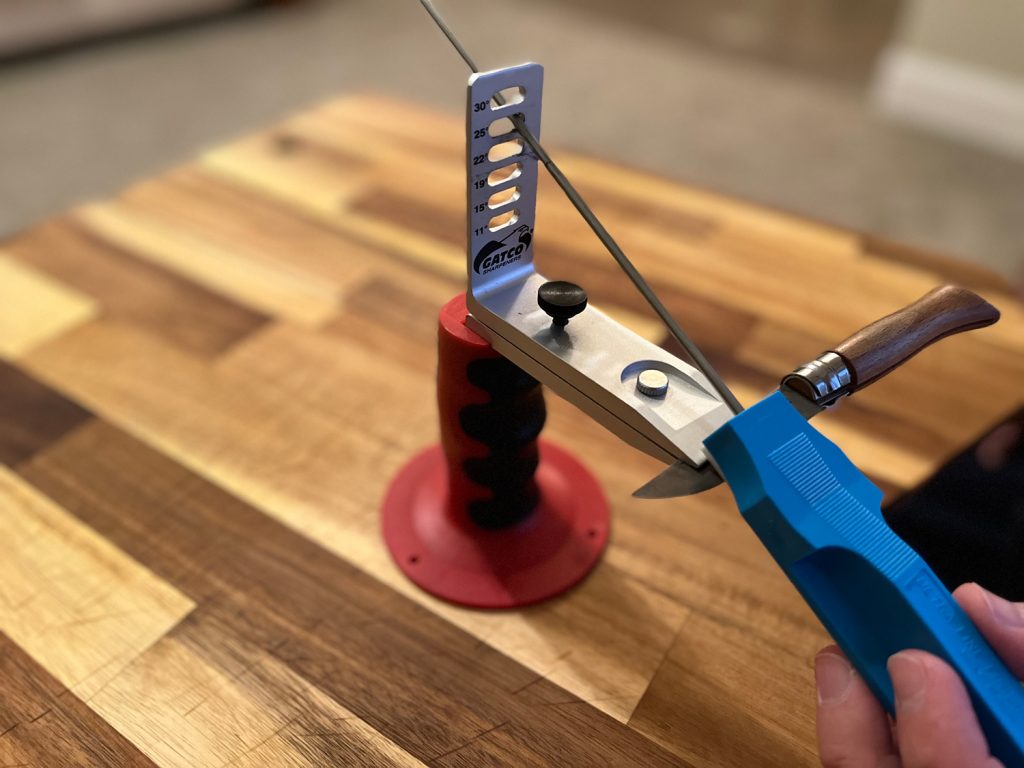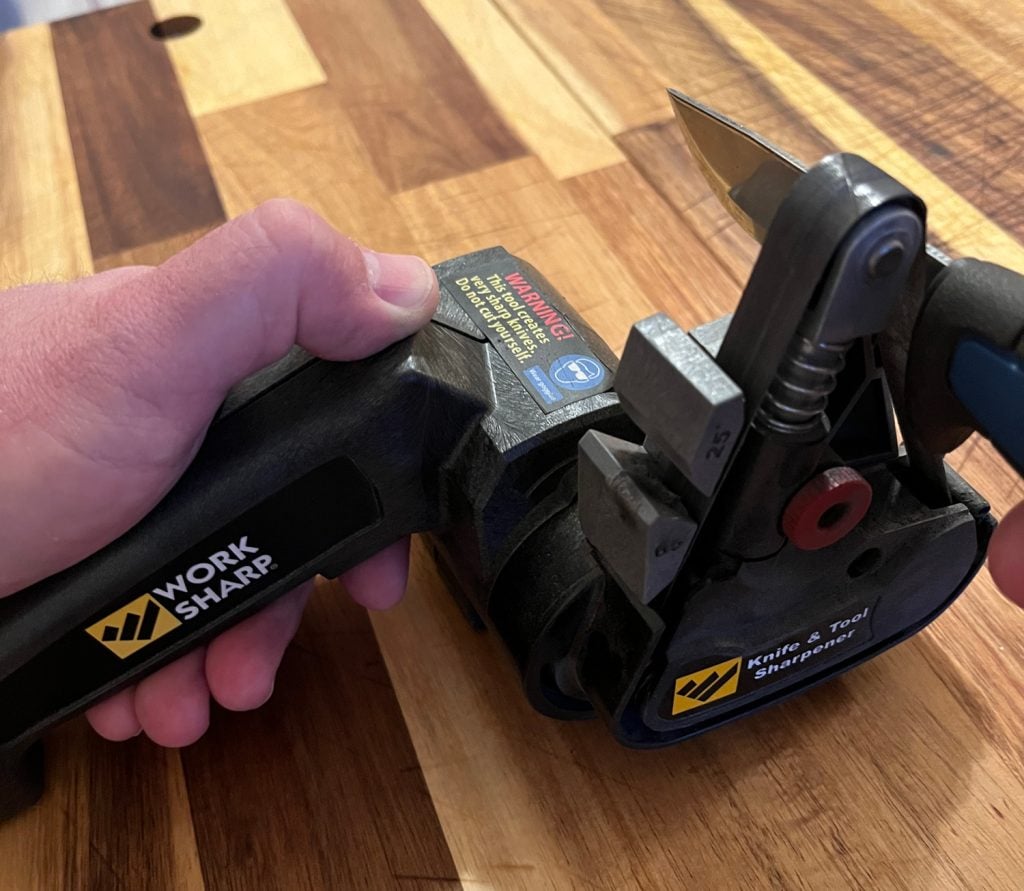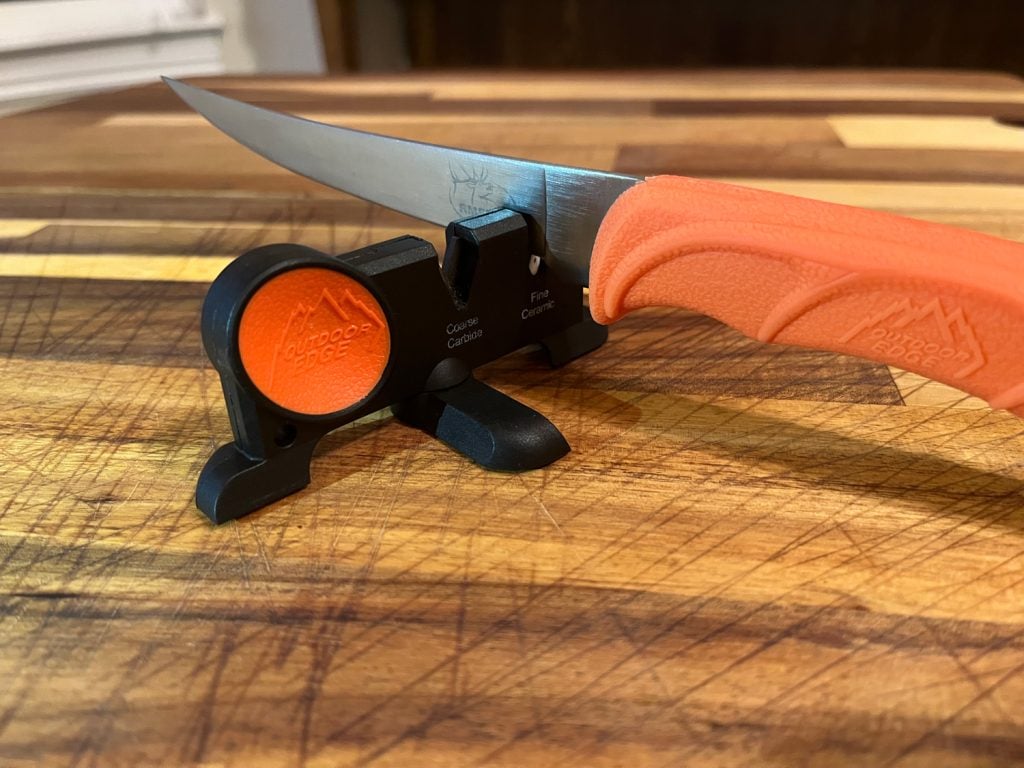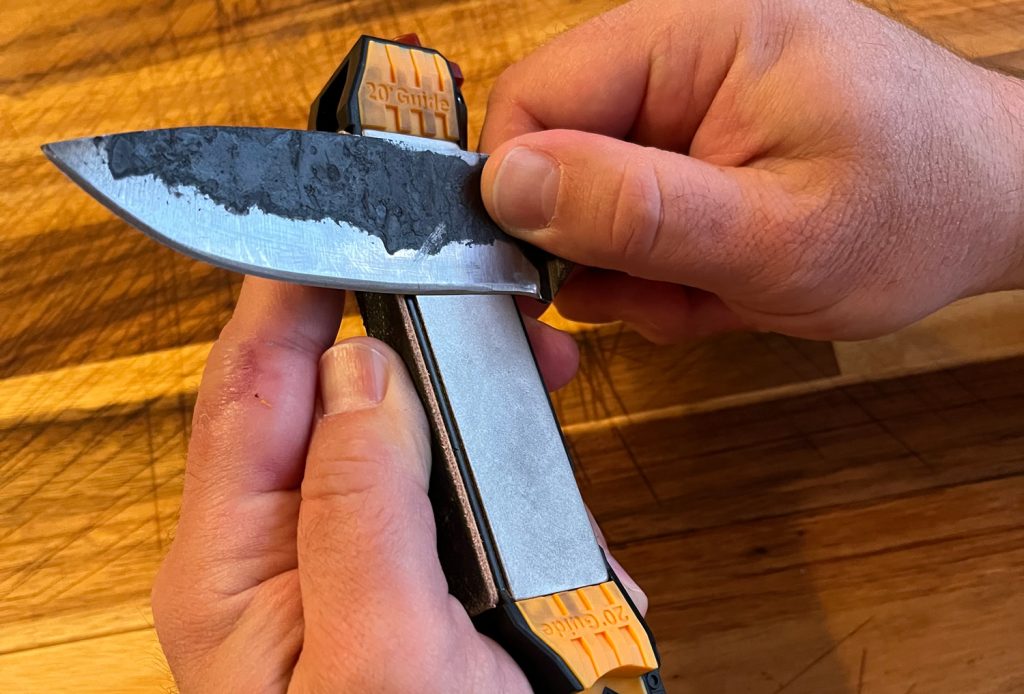Knife Sharpening Tips & Tools

Knives are tools that have a countless number of uses and come in a similarly countless number of styles and designs. One thing all knives have in common is that whatever it is you’re using it for, it will do a better job if it’s sharp. Replaceable blade knives have come a long way over the past few years. Today they are used for EDC purposes as well as hunting applications. I own and use the Outdoor Edge Razor-Blaze replaceable blade knife. I use it frequently in the field and perform great in field dressing, skinning, and quartering duties.
I also carry at least one, but most of the time two backup fixed blade knives in my hunting pack along with a trusted folding pocket knife. One thing that all non-replaceable blade knives have in common is that if you use it enough, the edge is going to require some maintenance to keep it sharp and working its best.
In this article, I’ll go over a few of the methods and tools I use to keep my knives sharp and the settings in which they function best. From simple folding pocket knives to beefy fixed blades, and from filet & game processing to kitchen & chef knives, these methods will help you keep your steel sharp and your confidence high the next time you reach for your knife of choice.
Rod/Angle Guided Sharpening Systems

Knife sharpening is a game of angles and consistency. I’m a big fan of anything that will allow me to choose the angle I want and help me consistently deliver sharpening stone to blade steel at that angle. There are a number of different sharpening systems that fit into this category on the market from trusted brands like Gatco, Lansky, and Work Sharp. The objective of all of them is very similar. They consist of a clamp to hold the knife in a stationary position, an angle guide that allows you to choose the angle of the edge you’re putting on your knife, and a rod guide with some kind of sharpening stone attached to it that works in sync with the angle guide to basically triangulate the degree of the sharpening stroke that is being applied to the knife blade.
I personally use the Gatco Ultimate Diamond knife sharpening system and it delivers great results and very sharp blades. It has coarse, medium, and fine diamond stones as well as a ceramic stone and an angled stone meant to be used on serrations. I love to pack this sharpening system on hunting trips and break it out when we’re sitting around in the tent or trailer at night when we’re getting prepared to head out the next morning. It gives me something to focus my thoughts on and clear my mind before jumping off the mental deep end and getting fully immersed in hunting activities the following morning. After I get all of the blades I packed razor sharp, someone else in camp is guaranteed to ask to use it on their knives as well. It’s become a great night before the hunt ritual and the confidence that comes from knowing my knives are sharp and ready to go goes a long way once I’m out in the field chasing game. This isn’t a sharpening system that I pack out in the field with me as it takes up a bit of room and requires a sturdy table top or other surface to use correctly. However, at home or in hunting camp sharpening systems like these are a great way to get consistently sharp knives.
Electric Belt Driven Sharpening Systems

You could realistically sharpen a knife on any old belt sander and professional knife makers do it all the time. I’m not a professional so I need some help getting the correct angle on the belt. I use a Work Sharp Knife and Tool Sharpener and have had a good experience overall with it. The Work Sharp uses ½” x 12” belts of different coarseness along with set angle guides to help you achieve consistently sharp knives. Belts range from coarse P80 grit all the way down to extra-fine 6000 grit and ceramic belts. I’m a hobbyist bladesmith and use the Work Sharp to help me make the transition from the bevel of the blade to the cutting edge. The coarser grit belts can really remove some material and the angle guides help me stay consistent pass after pass. The Work Sharp is also my go-to method to sharpen and tune up kitchen cutlery. After a few passes with the 6000 grit belt, chef’s knives, steak knives, and filet knives are back to a razor’s edge.
As I said earlier, the coarser belts can remove material quickly so care must be taken to not leave the blade in contact with the belt for too long. Doing so can result in an altered blade profile that is not easily repairable. You also need to be very careful when working towards the tip of the blade. As you move the blade across, eventually you lose contact with one side of the angle guide and it can be easy to round off the sharp tip of the knife. Obviously, sharpening systems like this one require electricity so they are best used at home on a steady surface in a well-lit area. With care and practice, the Work Sharp Knife and Tool Sharpener can produce very sharp edges in a very short amount of time.
Quick Edge Restoring Sharpeners

When processing game meat at home, I’ll frequently pause to restore the sharp edge required to quickly and easily separate meat from bone and break that meat down into final cuts. A few years ago, I purchased an Outdoor Edge WildLite Kit and I’ve used it pretty extensively to process game here at my home. The WildLite Kit includes the Outdoor Edge Sharp-X Knife Sharpener, and it’s become my go-to method for quickly restoring sharp edges when processing game. It’s small and simple offering only a coarse carbide or fine ceramic option. I’ve found that 10-20 passes on the fine ceramic rods does a great job of restoring a very sharp edge and helps the sometimes overwhelming task of processing a game animal go much more smoothly. My three go-to knives for game processing are a long, stout butcher knife, a semi-flexible boning knife, and a flexible filet knife. I’ve found that all three types of knives respond well to the Sharp-X Knife Sharpener.
This is a small and versatile sharpener that can easily be thrown in a hunting pack and used to restore a sharp edge in the field when field dressing or skinning game. I wouldn’t use it on a very dull knife or any blade in need of serious repairs, but to quickly restore a sharp edge on a well-maintained knife, this is a great option.
Multi-Purpose Field Sharpeners

There are a ton of these sharpeners on the market right now, all meant to be small, portable, and keep edges sharp. My personal favorite right now is the Work Sharp Guided Field Sharpener. It has set angle guides, coarse & fine diamond surfaces, multi-use ceramic rod for blades & fish hooks, a leather strop, and a small internal storage compartment all together in a light and portable package. This is the best all-around sharpener in my list. I’ve been using it a lot recently and I’m really impressed by the design of the product and the very sharp edges it produces.
This sharpener has found a permanent place in my at-home sharpening routine and in my hunting pack. Larger blades can be sharpened in two or three stages and still come out very sharp. I’m sure there are a lot of other great sharpeners out there in this category, but for me the Work Sharp Guided Field Sharpener checks all of the boxes. It will sharpen, hone, and polish every hunting blade and pocket knife I own with consistently repeatable results. I wouldn’t use these diamond surfaces on my kitchen cutlery or filet knives simply because the fixed 25 degree angle on them is steeper than the 20 degree edge I prefer on my kitchen and filet knives.

As the old saying goes, “A man without a knife is a man without a life.” Hopefully you can use some of the tips and tools in this article to keep your blades sharp so the next time you reach for your blade of choice it will perform at its best.

1 Comment